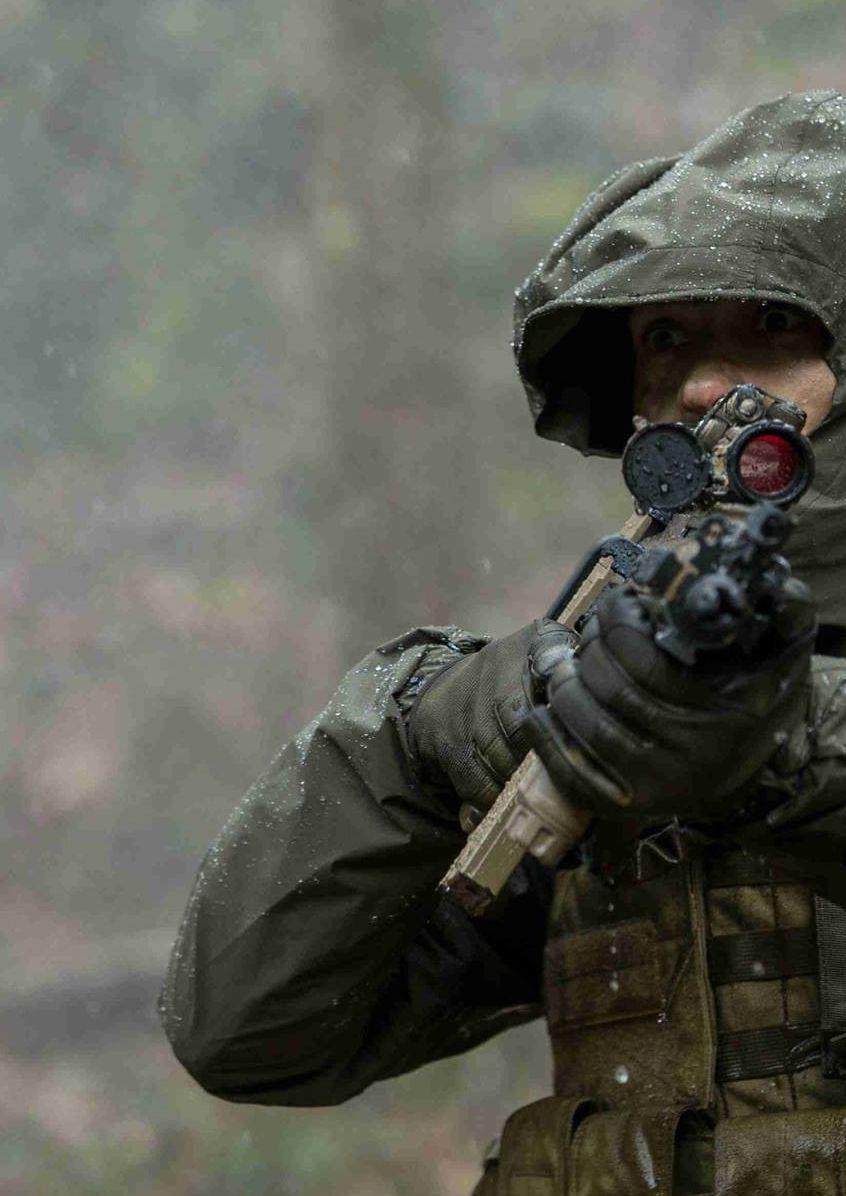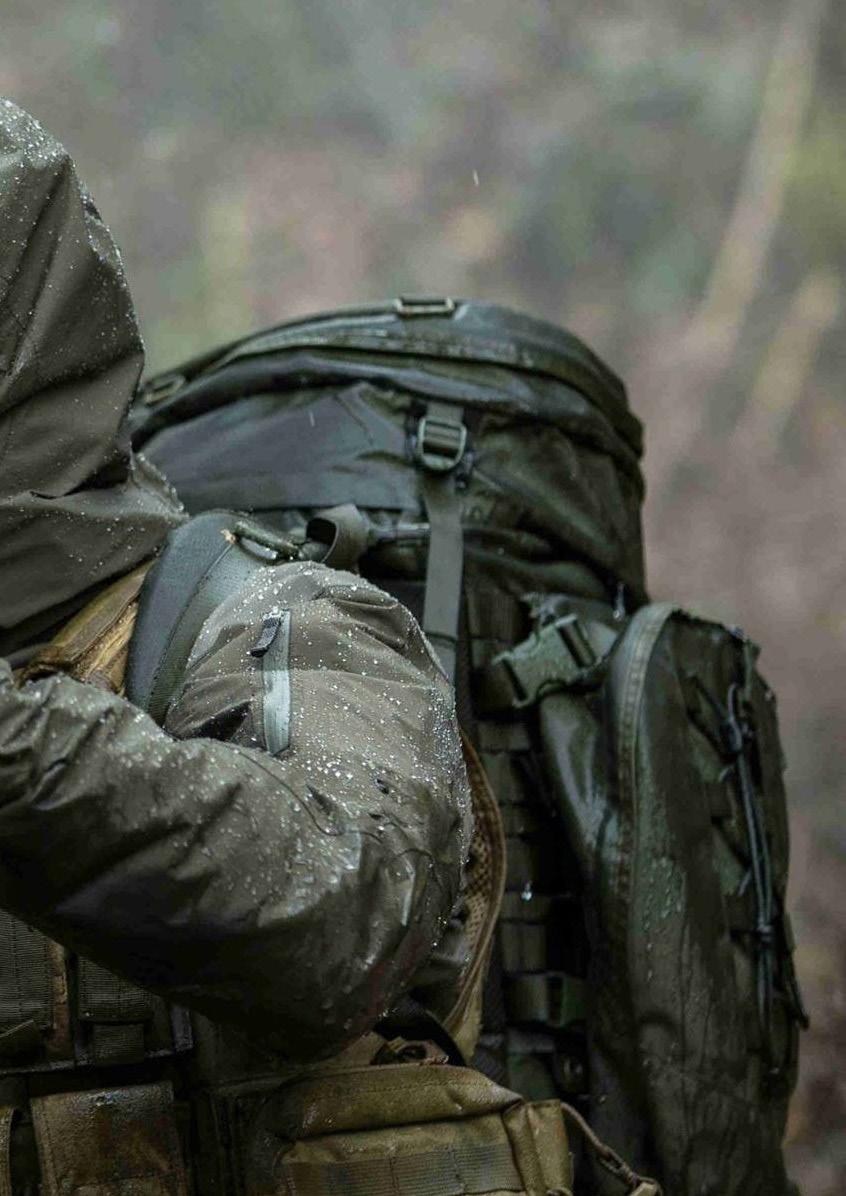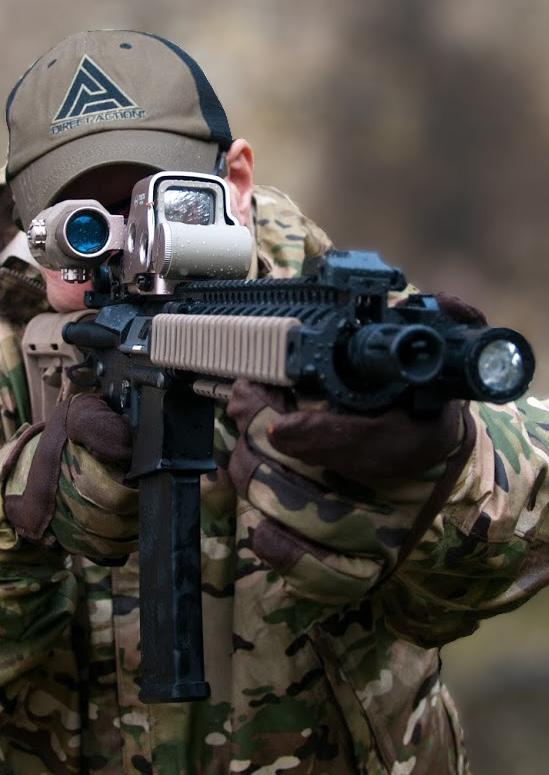
9 minute read
THE CAGE: SHELL GARMENTS
THE CAGE: SHELLING OUT
AS THE AA CREW CONTINUE THEIR QUEST TO BRING YOU THE ULTIMATE CLOTHING AND GEAR SOLUTIONS, THEY TURN THEIR ATTENTION TO “SHELL GARMENTS”; THOSE THAT WILL KEEP YOU PROTECTED FROM THE ELEMENTS WHEN THE WEATHER - AS IT INEVITABLY WILL - TURNS NASTY. BILL SETS THE SCENE…
Ihave to say that in my years of playing airsoft around the world I’ve come across many “fair weather airsofters”, those that come out to play only when the weather is good and head back to their workshops and armouries when the sky turns grey, which is fine by me if that’s the way you like your airsoft! There’s nothing wrong with this at all in my mind, as we all love to play a game when the sun is shining, it’s dry and hot and the only things you have to worry about are whether you have enough water and if the heat is going to put your GBB over the site limit...
Sadly, I’ve also encountered players that seem to have no respect at all for “Old Ma Nature”; players who will come out to a game in the driving rain or falling snow and then have a problem because they are totally unprepared for the conditions. Games I’ve been to in the winter have been called to a halt as players get wet and chilled and I’ve even been at games where they’ve been called off completely due to players starting to get hypothermic!
I’m not saying for one moment that I’m a better player because I have “all the kit” (and have invested over the years in the right pieces) but I will say that I have the utmost respect for other players that do their research and adapt their loadouts appropriately for the conditions they will be facing. I actually LOVE to play in the pouring rain, embracing the conditions to my advantage (rain can be especially “noisy” in a woodland setting or a CQB village… Just sayin’…). I especially love to play when it’s snowing and on a couple of memorable occasions have had the joy of doing so.
We have a couple of mantras at AA, the first of which is that “there’s no such thing as bad weather, just bad kit” and the second being “any fool can be uncomfortable”! The crux of this is making sure you have the right clothing, understand it and know how to use it! If you look back in the “AA Archives” you’ll find a number of articles on the technical characteristics of clothing, clothing systems and how they really work, however, when it comes to “shell” garments, fundamentally you have two choices: “Hard” or “Soft” shells.
The differences between a “Soft” shell jacket and a “Hard” shell jacket are still somewhat “murky”, even though both technologies have been available for some considerable time now. They both offer a variety of benefits, from comfort to protection - so which is right for you and for what conditions?
Simply put, “Hard” shell is a waterproof jacket with a hood and matching trousers. Occasionally insulated, they’re designed to provide lightweight, durable and waterproof, breathable protection in rain or snow whilst allowing you to tailor your insulating and wicking layers beneath. The term “Hard” works here as generally the “face” (outer) fabric isn’t very stretchy, has a solid feel and is very durable. When you compare a hard shell to a soft shell, you can tell the difference by feeling the fabric and listening; a hard shell jacket typically makes A LOT more noise than a soft shell jacket due to the “heavier” face fabrics used to get that durability.
A “Soft” shell jacket is usually water-resistant (NOT water-PROOF in the main!) and offers more stretch and movement in the fabric but is still a breathable
shell that offers some protection from light snow and rain. Some soft shells feature waterproof/breathable technology but most are just water repellent. They are designed to move with you and help you maintain a comfortable and optimal body temperature during high-energy activities, although some soft shell jackets feature an insulated (or fleece) lining that may give additional warmth.
Once you know this fundamental difference between the two technologies you can be better placed to make your choice of what will work best for you. Hard shell will keep you dry (until you get wet; everything has its limits!), whilst Soft shell will keep you dry to an extent but also give you greater freedom of movement. You can combine a Hard shell with a Soft one but then you get into implications on total breathability/perceived comfort of your overall system… However, that’s another story for another day!
WHAT’S NEW WITH THE CREW?
I’m constantly updating my personal “gear locker” but, simply put, I have a number of GORE-TEX and similar technology jacket and trouser sets in my collection in different colours and camos, from the likes of Wild Things Tactical, UF PRO, Tasmanian Tiger and Clawgear. As I said before, I’ve got many years (and a lot of buckeroos) invested in my airsoft gear and coming from a mountaineering background I’ve used some of the kit in true “anger” in some pretty wild places!
However, when I got together (virtually still…) with the AA crew, I asked them “Do you use a Waterproof or Soft Shell jacket? If you do, when you use it, what model, and why that model in particular?” This is what they told me:
Jonathan: “Has to be Arc’teryx soft shell in “Crocodile”, superb for all types of weather!”
Chris: “British Army issue DPM Gore-Tex set, or Australian issue Gore-Tex Jacket. The DPM set has to be one of the best sets of GoreTex I’ve ever bought; cheap, never re-proofed and NEVER leaked! Softshell? I’ve had a Trespass one I’ve used in the past that’s worked nicely to keep me warm but now have two Aussie issue ones that are great (if lacking in pockets on the arms!).”
Boycie: “I have a number of soft shells which I use depending on what I am doing. For Pyro/SFX I use a Herock Orange one for the Higher Vis that is needed in that line of work. Others I use are my “work” ones in black which are just a generic brand depending on when I order them in. I’ve also got a US Army Issue MC one which has a matt finish to the cloth.”
Stewbacca: “I have a much-loved and used Helikon OD Soft shell jacket that me and my old Honey Badgers teammates all got to be matching, like we did with our OD 6094 plate carriers! I use it quite often even over here in the tropical weather, although it isn’t outstanding in terms of waterproofing versus my 5.11 Gore-Tex, but it keeps the wind off you (or the sun if it’s bright) and it is lightweight enough to not resent carrying around strapped to a backpack, or rolled up inside it. Perfect for after the sun goes down on long day trips when it gets a little cooler or there’s a light shower! It also has plenty of velcro with two nametape bars, one either side of the chest and pads on each shoulder/upper arm for patches, along with zip-open armpits which are a godsend for ventilation!”
Jon: “Along with Bill I’ve done a fair amount of research into this area and I find that an issue GoreTex set over a low profile insulated jacket when it’s really cold gives a great, usable and versatile balance!”
Bill W-R: “Not “Reaper Ops Downpour-Proof” (and that was biblical as anyone that was there on the day in question will tell you!) but I run a soft shell shower proof jacket that I bought online which is part of the teams clothing choice.”
Jimmy: “I have no preference on brand or design if I’m honest! For me a softshell is a softshell. I will wear it whether it’s from the supermarket or 5.11, if it’s good! I’ve worn them for years long before I ventured into airsoft. I purchased my first tactical softshell last year online, I think it was it was a Kryptec pattern, a pukka jacket for the money, less than £30 and very comfortable, with more zips than needed. Unfortunately I outgrew it quickly - either that or during lockdown it shrank in the wash… I bought a new one a few weeks ago (it must be good, it’s the same as Bills!) in Multicam Black, but this time in XXL and fits like a dream, definitely a good buy! I haven’t really put it through anything demanding as yet but time will tell, but for the money you can’t go wrong. I acquired it from Pete at Platoon Stores locally and this one is cut better than the eBay one and I imagine it will withstand the elements much better. The rear of the jacket has been made longer as well and the peak on the hood is to deal with water run-off. The elasticated cuffs make life easier when taking off or putting it on as you don’t have to keep setting the velcro straps, but I feel the drawstring at the waist could be a bit beefier. I’m going to have to subject it to some bad weather to see how it holds up!”
Miguel: “We mostly have good weather in Portugal, so protection against the rain is not at all a priority! If we do have a “bad” day, usually a normal

CLICK/TAP IMAGES FOR MORE INFORMATION

“I HAVE THE UTMOST RESPECT FOR OTHER PLAYERS THAT DO THEIR RESEARCH AND ADAPT THEIR LOADOUTS APPROPRIATELY FOR THE CONDITIONS THEY WILL BE FACING. I ACTUALLY LOVE TO PLAY IN THE POURING RAIN, EMBRACING THE CONDITIONS TO MY ADVANTAGE (RAIN CAN BE ESPECIALLY “NOISY” IN A WOODLAND SETTING OR A CQB VILLAGE… JUST SAYIN’…).”
thermal shirt or a polar one under an ACU jacket works or, in extreme cases, a “Patriot” style jacket.”
Dan: “For the last year and a half I’ve been using a First Spear Windcheater soft shell. It’s not a true rain jacket but it’s also not noisy like a true rain jacket. It’s proven to be quite durable and waterproof but also roomy enough that I can wear my Arc’teryx LEAF Atom underneath for extra insulation.”
In closing, you’ll see a couple of new names in the “Legion Crew List”; Miguel Olivera from Portugal and Dan A from the USA who have both joined us to provide coverage from their own “neck of the woods” along insight to different gear and brands that they work with and use themselves. We hope you’ll welcome them and we look forward to their stories in coming issues!
Suffice to say though, that a decent waterproof for those of us in the UK is a “must have” (gotta love that “liquid sunshine, right?) but this, of course, varies with different climates we may encounter. When I had the pleasure of joining the Greek players for “WARZONE 6” I definitely needed insulation at night in the mountains but not a waterproof. However, when I played regularly in Florida staying dry yet dealing with humidity during Hurricane Season proved a HUGE challenge…
My personal advice is that the best thing you can do is find out the conditions where you’ll be playing and what “Old Ma Nature” may throw at you when you’re there; we can work with her, but never beat her! Do your research and gain an understanding of WHY you use a certain technology, where and when it works best and then adapt your clothing system accordingly - and if you’re in the UK… buy some waterproofs! AA











